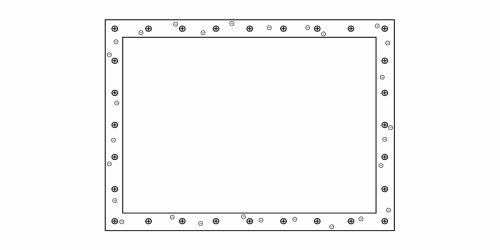ISOLATING EMI
Electromagnetic interference (EMI) can be difficult to isolate for a variety of reasons. EMI can travel via conductive radiation, via cables and power cords, or electromagnetic radiation which can pass through walls and other structures. For a sensitive instrument affected by EMI, the first step is to make sure the system is properly grounded. This can dissipate troublesome static buildup from the system.
HERZAN FARADAY CAGES  -
Animation of Faraday Cage Concept - Click to Enlarge
-
Animation of Faraday Cage Concept - Click to Enlarge
A Faraday cage, at its most basic, is a box made of conductive material. The Faraday cage essentially acts as a hollow conductor. When confronted with an external electrical field, the electrical charges within the cage’s conducting material will rearrange themselves, resulting in zero field in the interior. Thus, a Faraday cage shields its contents from electromagnetic radiation in the surrounding area and provides an isolated volume in which an electrically sensitive system can be placed. The cage should be well-grounded in order to dissipate the accumulated exterior.
Faraday cages are relatively simple to construct. All you will need is a six-sided box made of conductive material. Many people will construct cages out of steel plate or wiring. Unfortunately, these materials produce cages which are heavy, hard to work with, and not very aesthetically pleasing.
Herzan takes a different approach. We’ve gone to great lengths to specify and test flexible conductive mesh material. We use multiple layers of this conductive fabric to ensure that our cages have excellent conductive properties. The cages will only be effective if they are well sealed, so we use conductive Velcro to ensure a tight seal on all doors and access points. We also employ other special conductive material to wrap cables which enter the enclosure to avoid parasitic EMI entering the system via inductive radiation. All cages are supplied with a grounding wire to ensure the charge on the cage’s exterior is properly dissipated.
These practices result in a Faraday cage which is lightweight, portable, and easy to work with, but doesn’t compromise isolation performance.
Sometimes it isn’t practical to employ a Faraday cage. For example,
retrofitting a large instrument like an
electron microscope or Magnetic Resonance Imaging (MRI) machines
would be very difficult. Additionally, these systems are extremely
sensitive to EMI and static fields, so Faraday cages may not provide
sufficient reduction for these applications.SEM
Image - Before EMI Cancellation
Fortunately, active EMI cancellation systems have been developed. The Magnetic Active Compensation System (MACS) utilizes a Helmholtz coil system along with a control unit, amplifier, and sensors that can bring a site into specification. It is capable of reducing large magnetic fields to 0.1 mG or less at the microscope column.
Essentially, the system brings about significant attenuation of free-space time-varying magnetic fields over moderate volumes. The MAC System attenuates mains-induced AC fields (and with the QDC option, ultra low frequency and geomagnetic field modulations) by direct broadband active feedback on the orthogonal magnetic field components. With the active shielding system in operation, magnetic fields are reduced by a factor of 30 or more over a protected volume of typically 2–5 m3.
Wideband active shielding employs the classic engineering
principle of negative feedback. Magnetic field signals detected by the
system’s axial sensors are amplified, phase-corrected, inverted, and
applied to each coil pair surrounding the protected volume. WhenSEM
Image - After EMI Cancellation the compensation system
closed-loop amplification is set just below the maximum stable point,
fields at the sensor are suppressed by approximately the reciprocal of
the vector magnitude of the axial open-loop gain coefficients. In the
immediate vicinity of the sensor, magnetic fields are reduced by a
factor of over 100.
Typical field reduction is a factor of 20 to 40 over a volume, which easily includes the column and the viewing chamber of the electron microscope. Attenuation of the interfering magnetic field components is continuous over a range of 10 Hz to 1.0 kHz.
Unlike some servo-based compensation schemes with discontinuous coverage and long adaptation times, the MAC System instantaneously cancels any spectral components within its range. Actual field reduction over a given volume depends on the interfering field gradient. With this system, sufficient high-frequency bandwidth is provided to ensure adequate compensation for AC line harmonics of significance (h1 through h15).
The MAC System for electron microscopy allows the user to install cost-effective sophisticated, environmentally sensitive instruments in sites that are unacceptable according to manufacturer specifications. Often, a user has been forced to either accept a lower performance level from an instrument because of adverse environmental conditions or to site the instrument in a less desirable location. Now, with the MAC system, environmental magnetic fields no longer limit the capability of high performance equipment in less than optimal environments. The AC system is designed to provide maximum attenuation at 50/60Hz with attenuation levels of 40dB or more (Figure 2a).
The QDC system provides wide frequency band attenuation from very low frequency (0.001 Hz) to 1000 Hz. Attenuation at lower frequencies is approximately 40 dB and performance slowly declines as the frequency of the noise in the environment increases (32 dB at 50/60 Hz and 14 dB at 500 Hz).
Download the a white paper describing the technology behind the MACS EMI Cancellation System by clicking here.
© Copyright 2011 Herzan LLC http://www.herzan.com/resources/technology/emi-isolation.html